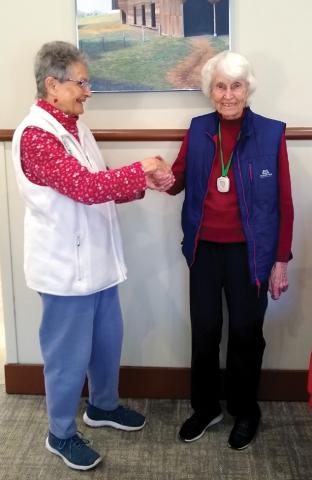"Peace of Mind" The History of Early Acceptance at Carol Woods

April 8, 2024 -
History of Early Acceptance at Carol Woods
In 1999, members of the Carol Woods management team recognized trends in the community that would require creative ideas and adaptations. The percentage of residents needing a higher level of support was growing faster than Building 5 could accommodate. The Priority List was growing much faster than residences were becoming available. This anomaly was primarily due to residents who moved in as couples but, after one died or moved to a higher level of support, the other continued to live in the independent living residence. There was no turnover of the residence.
To address some of the issues, between 2000 and 2012 Carol Woods constructed more residential space without destroying the nature of the campus. Buildings 6 and 7 provided space for 24 more assisted living residents. This was followed by the addition of 18 independent living apartments in a new wing added to Building 1. At the same time, the next step was to look at the possibility of serving residents on the Priority List in ways that would help them feel more a part of the community.
In 2007, Carol Woods leaders met with the Special Entities Manager at the NC Department of Insurance (DOI). Carol Woods proposed the concept of a Continuing Care Without Walls. They developed talking points that contained the cornerstones of the eventual Early Acceptance program at Carol Woods. In July, after review by the DOI legal department, it was determined that the program would not qualify under the current statutory framework because the proposed program did not “furnish lodging” to off-campus residents.
Once that ruling was made, Senator Ellie Kinnaird was asked to sponsor a bill that would create a new category of residents now known at Carol Woods as Early Acceptance (EA) residents. SB354, Continuing Care Without Lodging, proposed to amend the then-current statute, Chapter 58–64, Continuing Care Retirement Communities. It passed and in 2010, and a new section was added for Continuing Care Without Lodging.
The Carol Woods Early Acceptance program is a model which creates a personal relationship with the participants while providing a safety net when they need higher levels of support. One of the key provisions of Early Acceptance is that the off-campus residents have all the rights and privileges of Carol Woods residents.
Currently, there are 144 EA residents. Since the inception of the EA program in 2012 the total is 284. When the EA program was conceived, actuarial figures predicted that a significant number of EA residents would move directly to higher levels of support. To date, however, only nine EA residents have chosen that option.
The Rules for Becoming an Early Acceptance Resident
You must be on the Carol Woods Priority List.
You have gone through the admission process, which includes interviews with the Vice President of Finance, a social worker, a health care provider, and the CEO. There is no additional admission process when you decide it is time to become an on-campus resident. Note: A change in health status will not preclude you from moving on-campus. However, it might mean that independent living will no longer be appropriate for you.
Your primary residence is within a defined local area, which is within an appropriate driving distance of Carol Woods.
You may remain in your own home until you decide to move to campus AND your name has come up on the Priority List for the desired floor plan. Note: Early Acceptance does not mean that you move up on the Priority List.
You will have a monthly fee and a one-time entry fee. Note: Approximately half of the entry and monthly fees can be deducted as a medical expense on income taxes.
When you decide to move to campus, your entry fee will be applied toward the current entry fee of the independent living unit you have chosen. If you move directly to a higher level of support, there is no additional entry fee.
You will have access to the health services provided by the health clinic; outpatient physical, speech and occupational therapies; 15 free days annually in assisted living or the health center; social and counseling services; nutritional counseling; and annual vaccinations.
What does it mean to be an Early Acceptance Resident?
Early Acceptance Residents receive the same orientation given to other residents who move to campus, as well as a mentor to provide information and introduce them to other residents and campus life. They are invited to join Newcomers 101 meetings, committees and special interest groups and to attend campus events.
When EA residents decide to move to campus, having established friends on campus helps to create a smooth transition. Wendy and Allen Fuller are a good example of the power of involvement. They were EA residents for six years before moving to campus. Early on, Allen became a member of the Wednesday Evening Concert Committee and Wendy began volunteering in the Carol Woods Gift Shop. Their initial plan of staying in their home until they needed a higher level of support gave way to “jumping at the opportunity to move in” as they “would like to grow roots and enjoy life on campus fully, before needing that help.” They felt at home almost immediately.
What do our current EA residents have to say about their involvement?
When asked about their Early Acceptance experience, EA residents respond:
“It is a wonderful source of security and well-being for us. We love gardening, swimming, and getting our health care from Carol Woods. We have made some fine friends at Carol Woods.”
“We love it. We are regularly involved in classes, speakers, and seminars. We eat on campus once or twice a week. We enjoy the rotating art exhibits and appreciate the vaccination services. We have met so many wonderful people.”
And, finally, “peace of mind” is the recurring theme.
– Sindy Barker
